 In general Thailand has hot weather. The seaside and the mountains can be cooler in some parts of the year. Now from north to south, you have a distance of roughly 1300km, with some ocean and some mountains. You know from home that the weather can be very different just a few 100 miles / kilometers away. Here it is no different. Thailand has a rainy season that is different depending on where in the county you are. I have made a chart to show you when you have he coolest temperatures and when you have the least rain.
In general Thailand has hot weather. The seaside and the mountains can be cooler in some parts of the year. Now from north to south, you have a distance of roughly 1300km, with some ocean and some mountains. You know from home that the weather can be very different just a few 100 miles / kilometers away. Here it is no different. Thailand has a rainy season that is different depending on where in the county you are. I have made a chart to show you when you have he coolest temperatures and when you have the least rain.
I have been many times in Phuket, Bangkok and Pattaya during the month of September and my experience with rain season was not that bad. It rains several times a day for 15-30 minutes and is then dry again for a few hours. Some days will be 24 hours of rain others will be cloudless. Tha past years they even had serious floods in some parts. If the beach is your primal reason for traveling to Thailand: avoid this period. If you go for traveling around, sightseeing, shopping and relaxation, then this period might even be better for you. Prices are cheaper, people have more time and you can have a great holiday anyway.
When does it rain?

How hot is it?

Try to avoid spending your first 3 days in Bangkok. If you start here after your intercontinental flight, there is a big chance by the third day you are so overwhelmed by the heat, the noise and the cars of the city, that you just will want to get out! I know this is a convenient way of starting your holiday in Thailand, from the plane into the big city. You are there anyway. But better spend the first 3-4 days on the beach. Bangkok is a hectic crazy city. It is hot, humid, busy, never sleeps, noisy, smelly... Keep this experience for the final days of your stay as you will be more used to he temperatures and the humidity and you will have had some good nights sleep.
The currency is Thailand is Thai Bath. There are coins 1, 2, 5, 10 Bath and notes of 20, 50, 100, 500 and 1000. See the money
ATM use
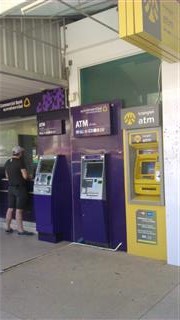 The cash machines can be found everywhere. Banks tend to have a few of them in every office, but many 7-11 shops have an ATM outside. There are plenty of ATM's around you, in tourist areas. But sometimes they are difficult to use. Sometimes they show messages in Thai, although you have selected English on he previous screen. In case the machine does something you do not expect, press cancel and go look for another one. Always take the highest possible amount as tre costs are unreasonably high.
The cash machines can be found everywhere. Banks tend to have a few of them in every office, but many 7-11 shops have an ATM outside. There are plenty of ATM's around you, in tourist areas. But sometimes they are difficult to use. Sometimes they show messages in Thai, although you have selected English on he previous screen. In case the machine does something you do not expect, press cancel and go look for another one. Always take the highest possible amount as tre costs are unreasonably high.
Selecting a machine
First look if the machine accepts your card. The Amex, Visa, Mastercard or Maestro logo should be on the machine or on the screen, otherwise this card is not accepted.
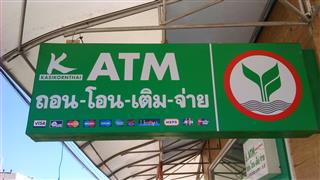
The procedure goes like this:
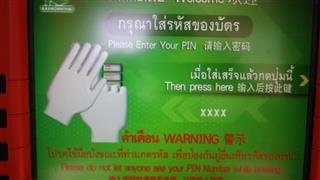
You enter your card and the first thing the machine asks is you pin code (some machines show a language selector screen before that). Enter your code with caution and cover the keypad with your free hand (as you would do at home).
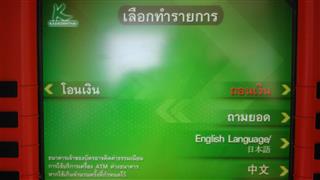
Sometimes you can the choose English language...
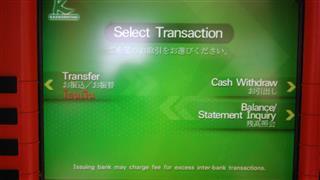
Then you have to press the confirm button. Sometimes this is a button next to the screen where the screen says “confirm”. Sometimes you have to touch the screen, sometimes the confirm is the green confirm button on the keypad. Sometimes, like shown in the picture you have to choose if you want to withdraw Cash. Nobody is at the ATM in Thailand to ask the weather forecast for the next week anyway, but that is not an option :-p
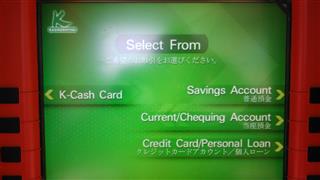
Then you have to choose Current or savings account. Choose “current”.
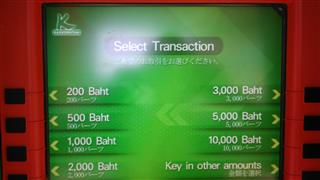
Then you can choose a fast cash option (preset amounts) or push "key in other amount to enter another amount". Now here comes a tricky part. The maximum amount the machines can give is 20.000 THB. Most machines do not give these huge amounts of money. Just for you to understand, 20.000 THB is a full nett two months pay in Thailand. You can try to get the 20.000... but
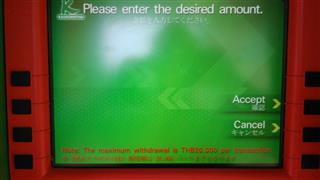
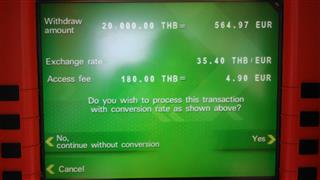
If the machines give a funny Thai message (or by coincidence in English “invalid amount”) try again with a lower amount. The machine will warn you that you will get charged a fee of (about) 220 THB (updated June 2017) for the transaction by the Thai bank on top of what you bank will charge you for it. You have to confirm this before the cash will be given. At any point in the procedure you can cancel the procedure by pressing the cancel button on the keypad.
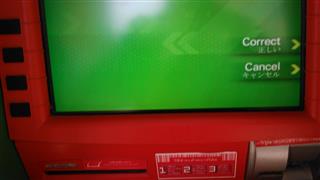
And there comes your money!
ATM use and Maestro
If you want to use the Maestro function outside of the EU, your bank needs to open it for the countries and the duration of your stay. In the past there have been many problems with skimming (illegal copy of the card), so that is why by default this is blocked.
ATM use and Credit cards
Depending on you credit card contract this could be the best option to get money if you have prepaid the amount to your credit card company. Then you only pay the 220THB to the Thai bank and the transaction is free (depending on your CC contract).
Some general remarks valid for any travel:
Do not take jewelry with you on a holiday. Yes, also leave your fancy watch at home.
Do not wear gold, diamonds if you go to run around in a city where most of the inhabitants cannot afford to buy something like that.
It's just common sense, but sometimes you don't think about it.
The best option to get more Baht for Euro or Dollar is to bring cash. It take a bit of searching in the street, to find the bank with best exchange rate, but it is worth it.
If you arrive at the Bangkok airport go completely down to the AirportLink and go to the exchange offices there. Never change money in the arrival hall!
Take the higher value notes with you as $/€ 100 - 500 notes get a higher exhange rate.
Last year we found a rate that was about 8% better for cash exchange of Euro, than the rate I got from my bank with all costs when taking money from the ATM with Maestro.
Car
All major car rental companies are represented in Thailand. Driving is on the left side of the road, and there are basically no rules. In fact there is traffic law, but it is hardly used. So if you drive in this country, drive carefully! Traffic comes in all forms and shapes (from motorbikes to elephants), from any side (yes, believe me) at all times, and many people drive drunk. Renting is car is a great way to see more of the real Thailand and you are the boss of your own time. But be careful, it's a jungle out there!
Rent a motorbike
Let me start with the most important rule of renting a motorbike: IF YOU DO NOT DRIVE A MOTORBIKE AT HOME, NEVER DO THAT IN A FOREIGN COUNTRY EITHER! (if you consider renting a motorbike, read the phrase a few more times). I work for a large travel company and we see customers die and get injured every year just because they lacked the skills of driving a motorbike. You will be busy enough focussing on the traffic, so it's important don't get distracted by the technical skills (shifting gears, etc...) on your motorbike. This said, a motorbike is a great way to discover Thailand. In the north there are even great and beautiful organized motorbike tours (see Section: What to do) . On the Islands a scooter or a motorbike are the cheapest options to see most places. The only thing, apart from traffic, you have to be aware off is the rain. Rain in Thailand can spoil your motorbike trip and most of all the roads can get slippery as hell. I've seen hundreds of accidents in Phuket on the mountain to get to Patong during rainfall. When possible do not drive in the rain, if you really want to drive in the rain drive slowly!
Rent a bike
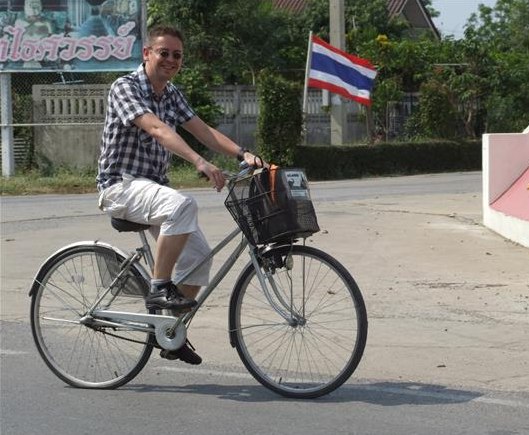 In Ayuttaya and in Sukhothai the bicycle is the best way to discover the ancient city. And even in bangkok there are some very interesting biking routes (see section: Things to do). It's a very fun way to get closer to the real life and due to the low speed it's easy to get in touch with the locals. Just forgive them their smile when they see a "Falang" on a bicycle. It will never be possible to explain to them why you did not take a taxi, when you have the money for it...
In Ayuttaya and in Sukhothai the bicycle is the best way to discover the ancient city. And even in bangkok there are some very interesting biking routes (see section: Things to do). It's a very fun way to get closer to the real life and due to the low speed it's easy to get in touch with the locals. Just forgive them their smile when they see a "Falang" on a bicycle. It will never be possible to explain to them why you did not take a taxi, when you have the money for it...
You pay between THB 100 (just a simple bike 1/2 day) and 3500 THB (full tour on high quality mountain bike with guide) depending on the region and the service offered.
Don't let the hot climate scare you off, on the bike you get a nice refreshing wind whilst driving.
I love biking in Thailand!
Motorbike taxi

Along the street you will see people sit around. They wear a special (blue or orange) jacket and there is a kind of board with numbers attached to the light pole. These are motorbike taxi's. They are the fastest and most dangerous way of transportation in the city. For 40-100 THB (depending on the distance) they drive you to where you want, through the traffic jam. Not the safest way to travel in Thailand, but surely a fast way of getting across town.
I've seen 2 tourists with a 5 years old boy and a large suitcase on one motorbike taxi, and that was not the most crazy thing I have seen on a motorbike taxi :-)
TukTuk
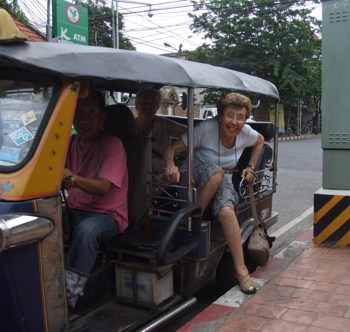 These are sometimes motorbikes with seating in the back or on the side, sometimes the tuktuk is a mini songthew (more on songthew below) car. The name is derived from the sound the two-stroke engine makes. The are fast, they get you anywhere in the city and it is fun. It's also a little bit dangerous sometimes, but live life on the edge and have fun. Be careful about tuktuk drivers. Not all are honest, some work in very difficult situations and need money. Especially in Bangkok I have bad experiences with TukTuk drivers. They try to bring you to gem-shops, other temples than the ones you wanted to see, to tailors, jewelry shops etc… When you are in the big bang, take skytrain, metro or grab a cab. TukTuk in Bangkok is also more expensive than taxi.
These are sometimes motorbikes with seating in the back or on the side, sometimes the tuktuk is a mini songthew (more on songthew below) car. The name is derived from the sound the two-stroke engine makes. The are fast, they get you anywhere in the city and it is fun. It's also a little bit dangerous sometimes, but live life on the edge and have fun. Be careful about tuktuk drivers. Not all are honest, some work in very difficult situations and need money. Especially in Bangkok I have bad experiences with TukTuk drivers. They try to bring you to gem-shops, other temples than the ones you wanted to see, to tailors, jewelry shops etc… When you are in the big bang, take skytrain, metro or grab a cab. TukTuk in Bangkok is also more expensive than taxi.
Songthew
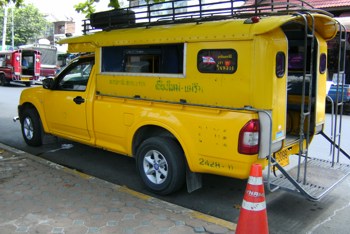 Is a kind of pickup truck with in the back two rows of seats (In Thai song=2, thew=row). It's the local private bus. There are different kind of songthews. Some act like a long distance bus and you pay per distance, others run as a local bus and you pay a fixed price per person. In Pattaya for example a zillion of songthews do the loop between beach road and second road, you pay 10 THB per person (sometimes tourists pay a little more). In Chiang Mai you have to ask the driver if he goes to your destination and agree on a price.
Is a kind of pickup truck with in the back two rows of seats (In Thai song=2, thew=row). It's the local private bus. There are different kind of songthews. Some act like a long distance bus and you pay per distance, others run as a local bus and you pay a fixed price per person. In Pattaya for example a zillion of songthews do the loop between beach road and second road, you pay 10 THB per person (sometimes tourists pay a little more). In Chiang Mai you have to ask the driver if he goes to your destination and agree on a price.
Mostly we talk about 15-50THB per person. If you have reached your destination, or where ever you want to get off, push the button (bell) and the car will try to get to the side as quickly as possible to drop you off. In a songthew, you always pay when you get off. You can also rent a songthew for private use. Then it works same as a taxi and the price is agreed before starting.
Taxi (this is a closed car with air-conditioning)
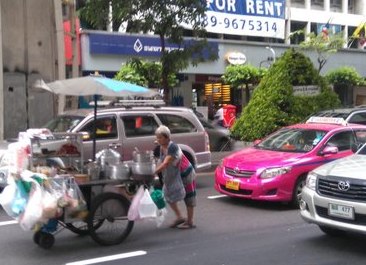 Most taxi's come in fancy colours in Thailand. Do some research online for the transfer prices from the airport to the city or to your hotel area where you want to go. Mostly a shared van is the cheapest option to get to your hotel from the airport. For private transportation the best option take a public taxi-meter. In Savarnabhumi Airport, you walk down to level 1 and follow the signs "public taxi". You queue up for a registration and you will get assigned a taxi driver. You receive a complaint form with all contact details and details to identify the driver, in case of a problem. On level 2 you will also find transportation services from AOT but they are more expensive. If people ask you "Where do you go?", "Taxi?" or whatever (many of them are illegal taxi's), just ignore them and continue down to level 1. The public taxi meters offer a “normal price” for the trip. At the toll booths they you have to pay the toll (expect around THB 100 for the trip to the airport)
Most taxi's come in fancy colours in Thailand. Do some research online for the transfer prices from the airport to the city or to your hotel area where you want to go. Mostly a shared van is the cheapest option to get to your hotel from the airport. For private transportation the best option take a public taxi-meter. In Savarnabhumi Airport, you walk down to level 1 and follow the signs "public taxi". You queue up for a registration and you will get assigned a taxi driver. You receive a complaint form with all contact details and details to identify the driver, in case of a problem. On level 2 you will also find transportation services from AOT but they are more expensive. If people ask you "Where do you go?", "Taxi?" or whatever (many of them are illegal taxi's), just ignore them and continue down to level 1. The public taxi meters offer a “normal price” for the trip. At the toll booths they you have to pay the toll (expect around THB 100 for the trip to the airport)
In town you can catch a taxi anywhere you want by just raising your hand.
Watch out, there are a lot of ripoffs... An indication to keep you on the safe side: a taxi ride up to one hour should be under 1000 THB. Count on 1000THB for an additional hour of about 4000-5000THB for a taxi all day. This is an interesting option if you want to gain time and see many things. Last year I did, starting from Bangkok, Kanchanaburi and the Tiger temple and ended in Ayuttaya for 4000THB with a taxi.
For a few kilometers, prices are variable between 40 THB and 600 THB :-). In Bangkok (mostly everywhere) you can ask to drive by the metered price or you can negiotiate a price. If you want meter and the driver does not want that, just get out and take another taxi. Airport to about anywhere is almost always fixed negotiated price. If a taxi agrees to drive by the meter they expect a tip...
If you order taxi for a particular time, beware the driver will be there 15 minutes early. I never had a taxi that was late in Thailand. So be prepared and get ready 20 minutes before the time you have the apointment. It embarrassing to get called out of the shower by the reception, if you plan to go somewhere.
Price indication for a taxi:
Savarnabhumiu Bangkok to downtown THB 500-800 (including Toll)
Phuket Airport to Patong THB 700
Traffic in general
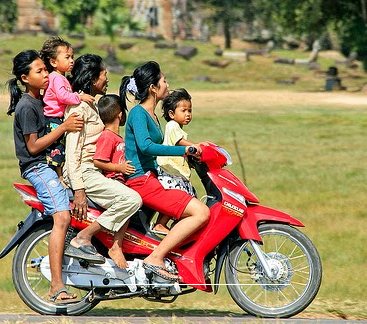 |
With death toll of 25.000 souls per year, the roads in Thailand are dangerous. Only during the 7 days of Songkran festival in 2015, 364 people got killed in 3300 accidents. Driving under the influence of alcohol, bad road conditions and many more reasons are the cause of this bad numbers. A whole family on a motorbike (4 children, mom and dad + a dog, chicken or duck) are a common sight. Always be careful, look in all 4 directions before crossing the road, any road, anytime.
The roads are busy, almost everywhere where you will go as a tourist. Bangkok is in fact one giant traffic jam.
The sidewalks are used for everything. There are markets, food stalls, massage parlours, hawkers and sometimes you even see elephants walking. The sidewalks have a kind of slopes on the roadside and this is very dangerous when you leave the center of the sidewalk. Let's face it, this is the most dangerous part of Thailand most tourists get involved with. I got slightly injured twice on my trips, some friends several times during one holiday, just because they did not pay attention to the slope on the sidewalk.
|
Bus
There are bus services between all major cities and villages. Long distance buses come in different classes of comfort and can be traveling during the day or the night. Different companies and other buslines can have completely different rolling material. I had brand new modern 25 seater buses between Chiang Mai and Chiang Rai, and 30 year old worn down buses in Bangkok. Some offer food and drinks, others don't.
Long distance buses leave from a bus station. In some regions, like Bangkok, you have different bus stations depending on the direction you want to go. To get into town from the bus terminal or to reach the bus station from downtown, you need the skytrain, a taxi, tuktuk, songthew,... to get there.
Traveling by bus is always an adventure in a foreign country. If you have time, it I a great way to meet Thai,to learn about the country and to get to he next bigger city. Most buses have a form of time table and will run frequently. Be sure to be on time. Not all the buses have strict timetables, some leave when they are full.
Let me tell you a small story about my experience at a bus station somewhere in Isaan to get back to Udon Thani.
We were waiting at the bus station for about an hour. People arrived and we were now 10 for the trip. The driver came with the minibus and cleaned it inside. I asked:”when do we leave?” he driver answered: “When bus full”. Now 7 more people arrived. The driver got into the van and drove off on his own. He could not take 18 people in his van. He came back with a big 54 seater bus. He put on his overall and started working on the engine. After 30 minutes he stopped his banging and oil changing, jumped on his motorbike and was off again. A half an hour later he came back freshly showered and ready to drive the 45 people who had gathered at this point at the bus stop to Udon Thani. Everybody happy...
Boat and Ferries
Skytrain - Bangkok only
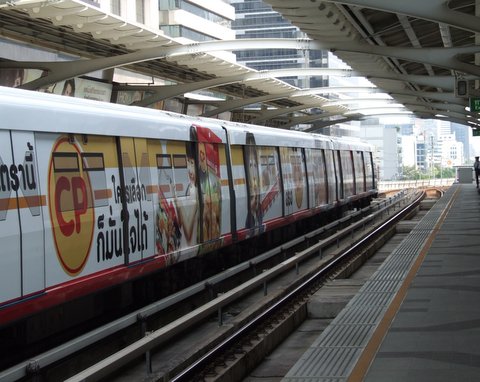 The main public transportation system in Bangkok is the BTS Skytrain Website
The main public transportation system in Bangkok is the BTS Skytrain Website  . It's like a subway/metro, but above the ground. The rails are high above street in the middle of the street. It is the fastest way to get to most places through Bangkok. About 600.000 people use the BTS Skytrain every day! You buy tickets at ticket machines in the stations (some only accept coins - keep your 10 THB coins!). There is an office the does not sell the simple tickets, but they can provide you with change for the machines. Every year I see more machines in the stations that accept paper money. Expect between 25 and 55 THB for a ride depending on the distance travelled. The machines have instructions in English and are pretty self-explainatory. Your ticket is a plastic card that you need to get back out of the station of disenbarkment. It's a clean wasteless & paperless system! Route map
. It's like a subway/metro, but above the ground. The rails are high above street in the middle of the street. It is the fastest way to get to most places through Bangkok. About 600.000 people use the BTS Skytrain every day! You buy tickets at ticket machines in the stations (some only accept coins - keep your 10 THB coins!). There is an office the does not sell the simple tickets, but they can provide you with change for the machines. Every year I see more machines in the stations that accept paper money. Expect between 25 and 55 THB for a ride depending on the distance travelled. The machines have instructions in English and are pretty self-explainatory. Your ticket is a plastic card that you need to get back out of the station of disenbarkment. It's a clean wasteless & paperless system! Route map  There is always an escalator and stairs to get to platforms, but they are sometimes a bit hidden. To come down from the platforms mostly there is only stairs. There are entries for disabled persons at some stations, but they are almost impossible tu use. More about the BTS Skytrain on Wikipedia
There is always an escalator and stairs to get to platforms, but they are sometimes a bit hidden. To come down from the platforms mostly there is only stairs. There are entries for disabled persons at some stations, but they are almost impossible tu use. More about the BTS Skytrain on Wikipedia  .
.
Metro - Bangkok only
In a part of town there is also the "undergorund skytrain", we know as a metro/subway. Because most of the city is swamp land the metro only covers the "dryer part" of town. Same procedure as for the skytrain, only here your ticket is token. Also very clean and very efficient.
Air travel - Getting there by plane
There is a good chance you will arrive in Thailand via Bangkok's Savarnabhumi airport (BKK) of Phuket International airport. These airports are modern, state of the art airports (Phuket gets a completely new airport in 2016). Savarnabhumi is clean, beautiful and very efficient. Before going through to pick up your luggage / or to get a connecting fight you need to go through immigration. Waiting can take up to 1.5 hours, but most of the time it takes just a few minutes.After immigration you are in the luggage pickup zone and almost out of the airport. To get to Bangkok city center you have different options. Taxi costs about 5-600 THB, Airport link 100 THB per person for the first part. If you need a sky train connection, you'll need to buy a new separate ticket for the skytrain.
If you need an connecting plane in Bangkok, you follow the signs for "transfer to (Phuket, Koh Samui, Chiang Mai, ...)". You'll have a separate immigration desk there to get into the domestic part of the BKK airport. The layout (flow of the people) of this connection corner in BKK airport is a bit strange, but OK you should survive it with some common sense. Just make sure you book your connecting domestic flight for departure from BKK (Savarnabhumi Airport), since the Don Muang Airport mainly used for point to point domestic flights is on the other side of town.
Air travel - Traveling in Thailand by plane
The safest option to travel in Thailand. Almost all regions have an airport close by. Thai Airways  , Bangkok Airways
, Bangkok Airways  , Air Asia
, Air Asia  and Nok Air
and Nok Air  are all reliable airlines for domestic travel in Thailand and the surrounding countries. Be careful when choosing the other "very cheap" airlines. Some of the airlines have a very bad reputation, even to the extent that they drag down the international score of all airlines in the country to the level of "red flagged"
are all reliable airlines for domestic travel in Thailand and the surrounding countries. Be careful when choosing the other "very cheap" airlines. Some of the airlines have a very bad reputation, even to the extent that they drag down the international score of all airlines in the country to the level of "red flagged"  .
.
Train
 Taking the train in Thailand is an adventure. Trains are always late and are old. I have traveled long distance, from Chaing Mai to Bangkok by train and from Sungai Golok to Hat Yai. Both of the trips were a unique experience... You can buy he tickets in advance at any train station in Thailand. But the website to buy tickets has been shutdown a few years ago. You have second and third class on most long distance trains and someone told me there is also a first class. Just think of second class trains like the trains in Europe in he 1960-ies. The speed of the average train, when rolling is a stunning 50-60km/h. Prices are reasonable. Count between 300 (Songai Golok to Hat Yai in second class) and 1500 THB depending on the distance).
Taking the train in Thailand is an adventure. Trains are always late and are old. I have traveled long distance, from Chaing Mai to Bangkok by train and from Sungai Golok to Hat Yai. Both of the trips were a unique experience... You can buy he tickets in advance at any train station in Thailand. But the website to buy tickets has been shutdown a few years ago. You have second and third class on most long distance trains and someone told me there is also a first class. Just think of second class trains like the trains in Europe in he 1960-ies. The speed of the average train, when rolling is a stunning 50-60km/h. Prices are reasonable. Count between 300 (Songai Golok to Hat Yai in second class) and 1500 THB depending on the distance).
 In Kanchanabury there is train to cross "The bridge over the River Kwai" and also a train to discover the "Hellfire pass", the track ends at the waterfalls in the area. (See section: Things to do Kanchanabury).
In Kanchanabury there is train to cross "The bridge over the River Kwai" and also a train to discover the "Hellfire pass", the track ends at the waterfalls in the area. (See section: Things to do Kanchanabury).
Here on the right you see the cabin of second class (sleeper train) during daytime. The picture was taken on the South route from Songay Golok To Bangkok.
Thailand has 220 volt power, like in Europe, but the plugs are the flat ones, like in the US.

Most power outlets in Thailand can fit both the round European plugs and the American ones, but the European plugs tend to fall out easily.
. 
Almost everywhere in Thailand you have good reception of mobile phones. The roaming costs can be substantial.After my first trip to Thailand I had a phone bill over 100€ on my Belgian phone. That mistake I will never make again. If you want to be free from roaming costs in Thailand, you can take an old phone with you and buy a local sim card. You can buy it at any 7/11 store or Family Market (Ask for a Happy sim card) . In order to buy a local sim card, you need to register it with ID, and you need to activate the card following the instructions (also provided in English) that come with the sim card.
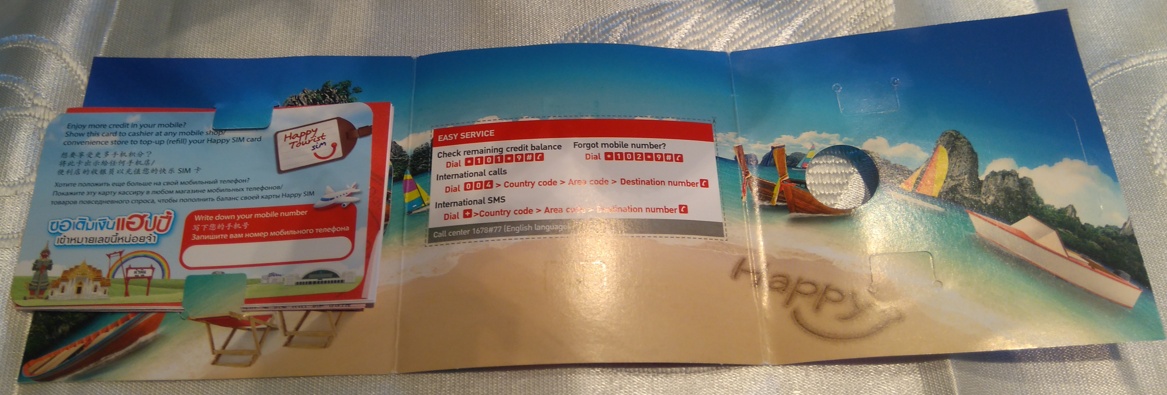
I always use HAPPY (DTAC) and I am happy with it. The cards come in all kind of prices, between 49 THB and 300 THB. The difference is the prepaid credit and the name on tha pack. My 300THB "tourist sim card" only had 100THB calling credit. So ask for the different sim cards and eventually buy credit separately. You sometimes get 7 days free Internet and Happy will send you messages all day to make you spend more. But hey, for 10-15 Euro per 2 weeks, I have internet, I call for taxi, make reservations at hotels and can call and SMS my friends in Thailand.
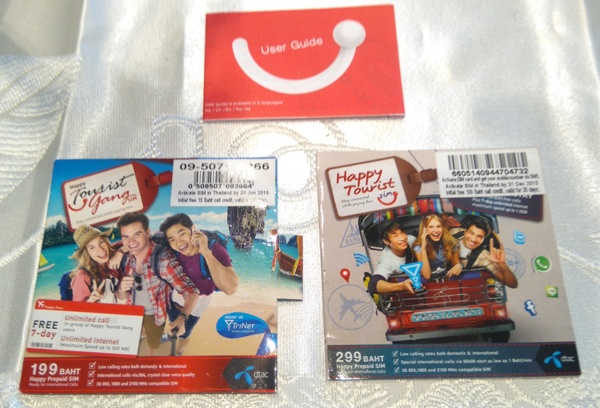
 In general Thailand has hot weather. The seaside and the mountains can be cooler in some parts of the year. Now from north to south, you have a distance of roughly 1300km, with some ocean and some mountains. You know from home that the weather can be very different just a few 100 miles / kilometers away. Here it is no different. Thailand has a rainy season that is different depending on where in the county you are. I have made a chart to show you when you have he coolest temperatures and when you have the least rain.
In general Thailand has hot weather. The seaside and the mountains can be cooler in some parts of the year. Now from north to south, you have a distance of roughly 1300km, with some ocean and some mountains. You know from home that the weather can be very different just a few 100 miles / kilometers away. Here it is no different. Thailand has a rainy season that is different depending on where in the county you are. I have made a chart to show you when you have he coolest temperatures and when you have the least rain. The cash machines can be found everywhere. Banks tend to have a few of them in every office, but many 7-11 shops have an ATM outside. There are plenty of ATM's around you, in tourist areas. But sometimes they are difficult to use. Sometimes they show messages in Thai, although you have selected English on he previous screen. In case the machine does something you do not expect, press cancel and go look for another one. Always take the highest possible amount as tre costs are unreasonably high.
The cash machines can be found everywhere. Banks tend to have a few of them in every office, but many 7-11 shops have an ATM outside. There are plenty of ATM's around you, in tourist areas. But sometimes they are difficult to use. Sometimes they show messages in Thai, although you have selected English on he previous screen. In case the machine does something you do not expect, press cancel and go look for another one. Always take the highest possible amount as tre costs are unreasonably high.








 In Ayuttaya and in Sukhothai the bicycle is the best way to discover the ancient city. And even in bangkok there are some very interesting biking routes (see section:
In Ayuttaya and in Sukhothai the bicycle is the best way to discover the ancient city. And even in bangkok there are some very interesting biking routes (see section: 
 These are sometimes motorbikes with seating in the back or on the side, sometimes the tuktuk is a mini songthew (more on songthew below) car. The name is derived from the sound the two-stroke engine makes. The are fast, they get you anywhere in the city and it is fun. It's also a little bit dangerous sometimes, but live life on the edge and have fun. Be careful about tuktuk drivers. Not all are honest, some work in very difficult situations and need money. Especially in Bangkok I have bad experiences with TukTuk drivers. They try to bring you to gem-shops, other temples than the ones you wanted to see, to tailors, jewelry shops etc… When you are in the big bang, take skytrain, metro or grab a cab. TukTuk in Bangkok is also more expensive than taxi.
These are sometimes motorbikes with seating in the back or on the side, sometimes the tuktuk is a mini songthew (more on songthew below) car. The name is derived from the sound the two-stroke engine makes. The are fast, they get you anywhere in the city and it is fun. It's also a little bit dangerous sometimes, but live life on the edge and have fun. Be careful about tuktuk drivers. Not all are honest, some work in very difficult situations and need money. Especially in Bangkok I have bad experiences with TukTuk drivers. They try to bring you to gem-shops, other temples than the ones you wanted to see, to tailors, jewelry shops etc… When you are in the big bang, take skytrain, metro or grab a cab. TukTuk in Bangkok is also more expensive than taxi. Is a kind of pickup truck with in the back two rows of seats (In Thai song=2, thew=row). It's the local private bus. There are different kind of songthews. Some act like a long distance bus and you pay per distance, others run as a local bus and you pay a fixed price per person. In Pattaya for example a zillion of songthews do the loop between beach road and second road, you pay 10 THB per person (sometimes tourists pay a little more). In Chiang Mai you have to ask the driver if he goes to your destination and agree on a price.
Is a kind of pickup truck with in the back two rows of seats (In Thai song=2, thew=row). It's the local private bus. There are different kind of songthews. Some act like a long distance bus and you pay per distance, others run as a local bus and you pay a fixed price per person. In Pattaya for example a zillion of songthews do the loop between beach road and second road, you pay 10 THB per person (sometimes tourists pay a little more). In Chiang Mai you have to ask the driver if he goes to your destination and agree on a price.  Most taxi's come in fancy colours in Thailand. Do some research online for the transfer prices from the airport to the city or to your hotel area where you want to go. Mostly a shared van is the cheapest option to get to your hotel from the airport. For private transportation the best option take a public taxi-meter. In Savarnabhumi Airport, you walk down to level 1 and follow the signs "public taxi". You queue up for a registration and you will get assigned a taxi driver. You receive a complaint form with all contact details and details to identify the driver, in case of a problem. On level 2 you will also find transportation services from AOT but they are more expensive. If people ask you "Where do you go?", "Taxi?" or whatever (many of them are illegal taxi's), just ignore them and continue down to level 1. The public taxi meters offer a “normal price” for the trip. At the toll booths they you have to pay the toll (expect around THB 100 for the trip to the airport)
Most taxi's come in fancy colours in Thailand. Do some research online for the transfer prices from the airport to the city or to your hotel area where you want to go. Mostly a shared van is the cheapest option to get to your hotel from the airport. For private transportation the best option take a public taxi-meter. In Savarnabhumi Airport, you walk down to level 1 and follow the signs "public taxi". You queue up for a registration and you will get assigned a taxi driver. You receive a complaint form with all contact details and details to identify the driver, in case of a problem. On level 2 you will also find transportation services from AOT but they are more expensive. If people ask you "Where do you go?", "Taxi?" or whatever (many of them are illegal taxi's), just ignore them and continue down to level 1. The public taxi meters offer a “normal price” for the trip. At the toll booths they you have to pay the toll (expect around THB 100 for the trip to the airport)
 The main public transportation system in Bangkok is the BTS Skytrain
The main public transportation system in Bangkok is the BTS Skytrain  Taking the train in Thailand is an adventure. Trains are always late and are old. I have traveled long distance, from Chaing Mai to Bangkok by train and from Sungai Golok to Hat Yai. Both of the trips were a unique experience... You can buy he tickets in advance at any train station in Thailand. But the website to buy tickets has been shutdown a few years ago. You have second and third class on most long distance trains and someone told me there is also a first class. Just think of second class trains like the trains in Europe in he 1960-ies. The speed of the average train, when rolling is a stunning 50-60km/h. Prices are reasonable. Count between 300 (Songai Golok to Hat Yai in second class) and 1500 THB depending on the distance).
Taking the train in Thailand is an adventure. Trains are always late and are old. I have traveled long distance, from Chaing Mai to Bangkok by train and from Sungai Golok to Hat Yai. Both of the trips were a unique experience... You can buy he tickets in advance at any train station in Thailand. But the website to buy tickets has been shutdown a few years ago. You have second and third class on most long distance trains and someone told me there is also a first class. Just think of second class trains like the trains in Europe in he 1960-ies. The speed of the average train, when rolling is a stunning 50-60km/h. Prices are reasonable. Count between 300 (Songai Golok to Hat Yai in second class) and 1500 THB depending on the distance). In Kanchanabury there is train to cross "The bridge over the River Kwai" and also a train to discover the "Hellfire pass", the track ends at the waterfalls in the area. (See section: Things to do Kanchanabury).
In Kanchanabury there is train to cross "The bridge over the River Kwai" and also a train to discover the "Hellfire pass", the track ends at the waterfalls in the area. (See section: Things to do Kanchanabury).
